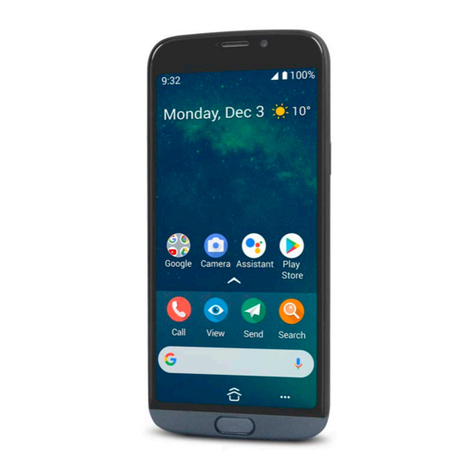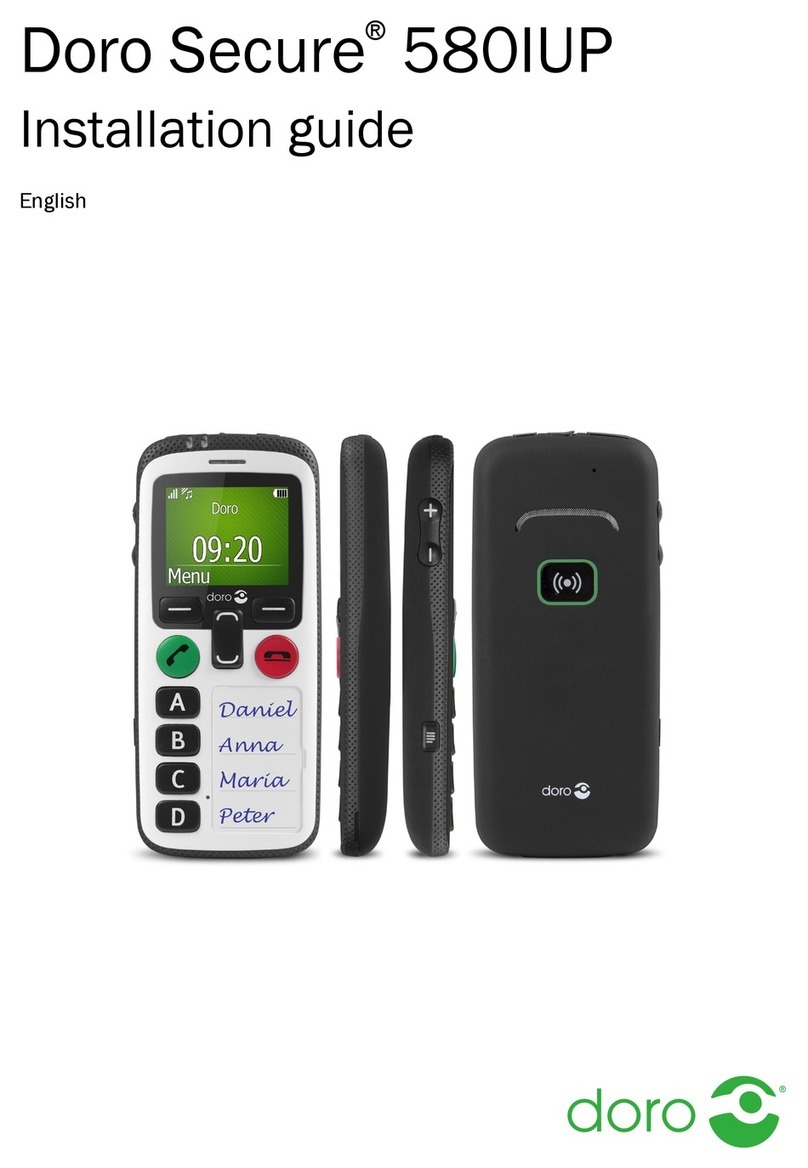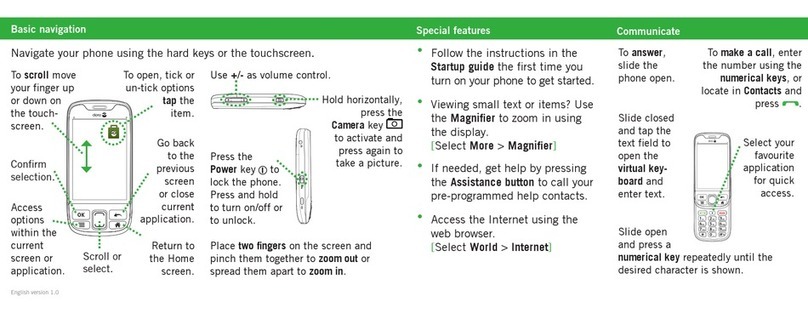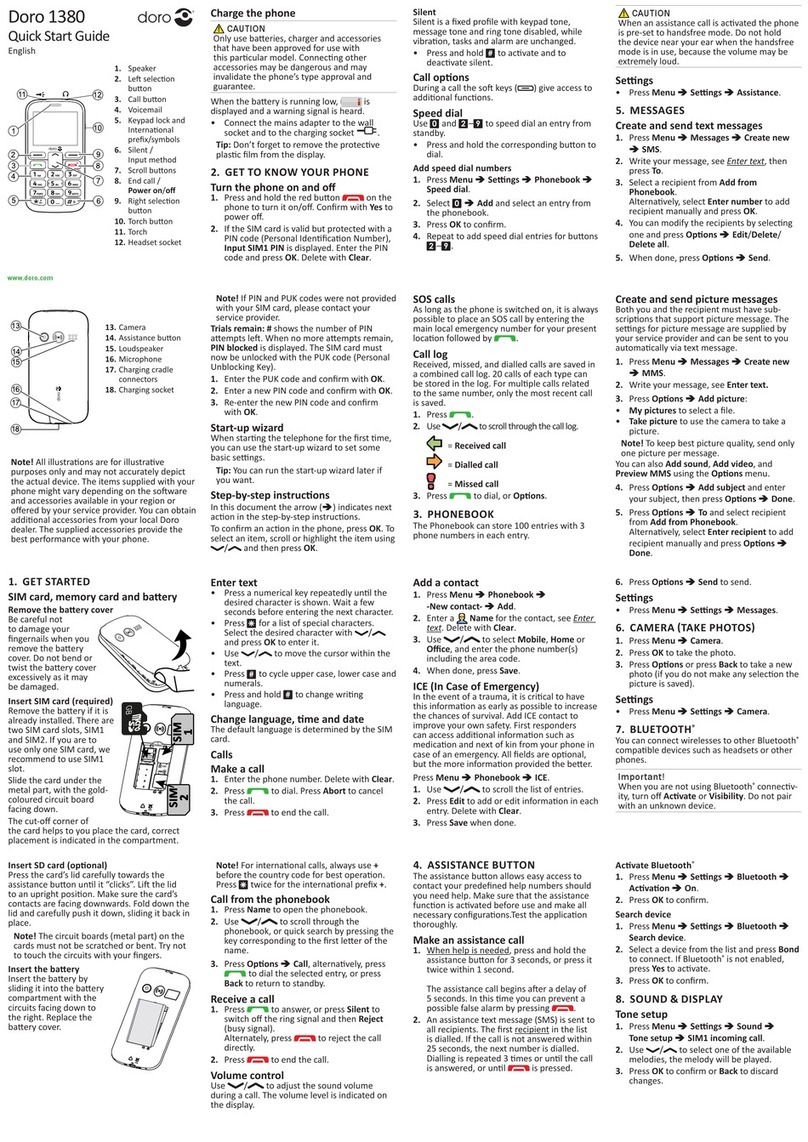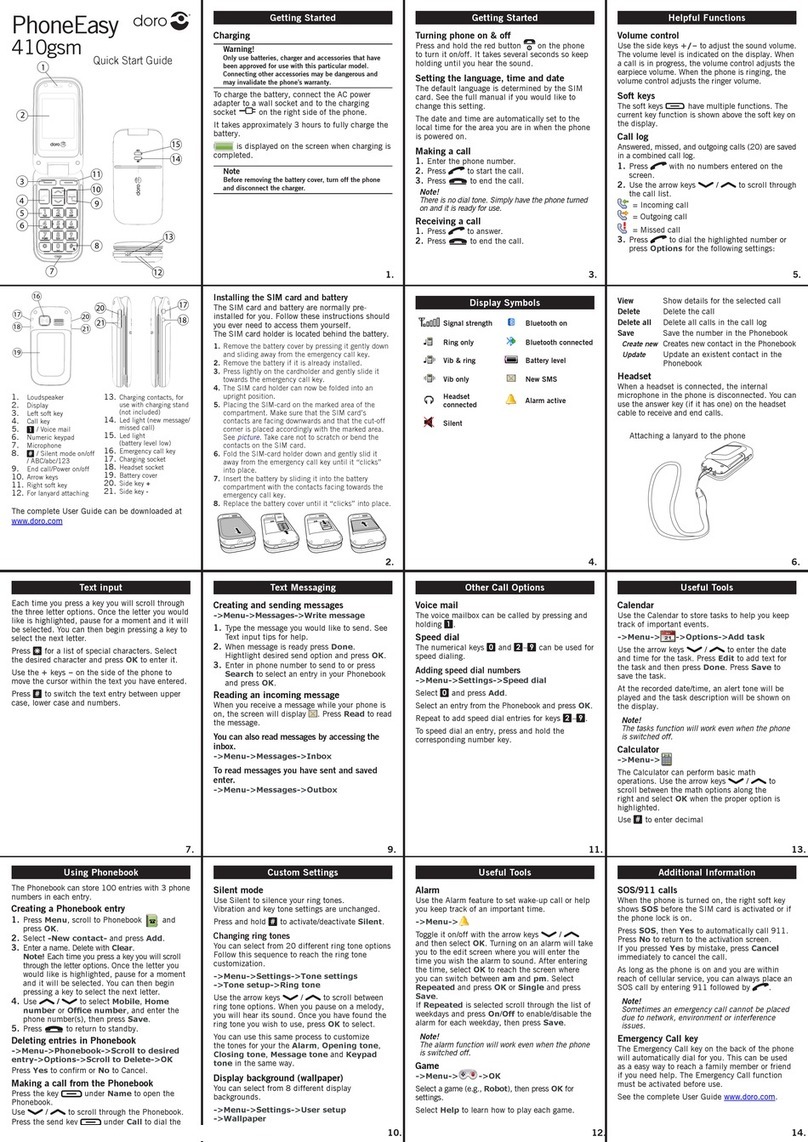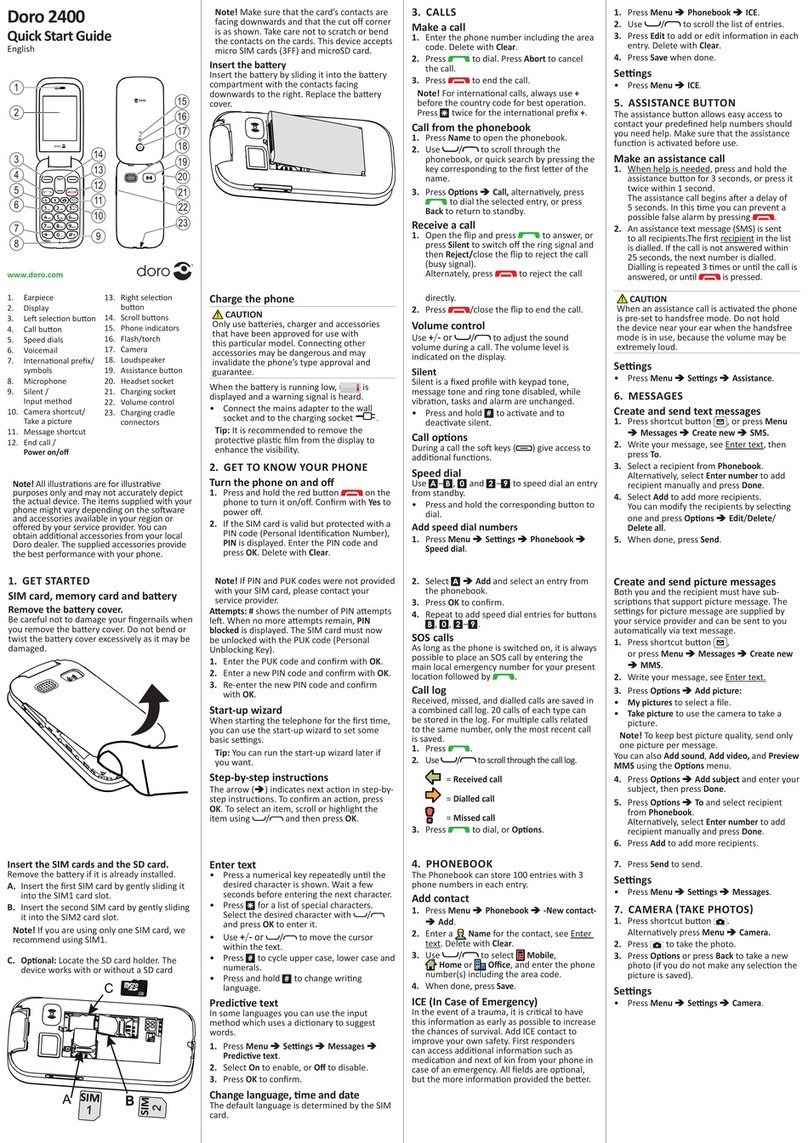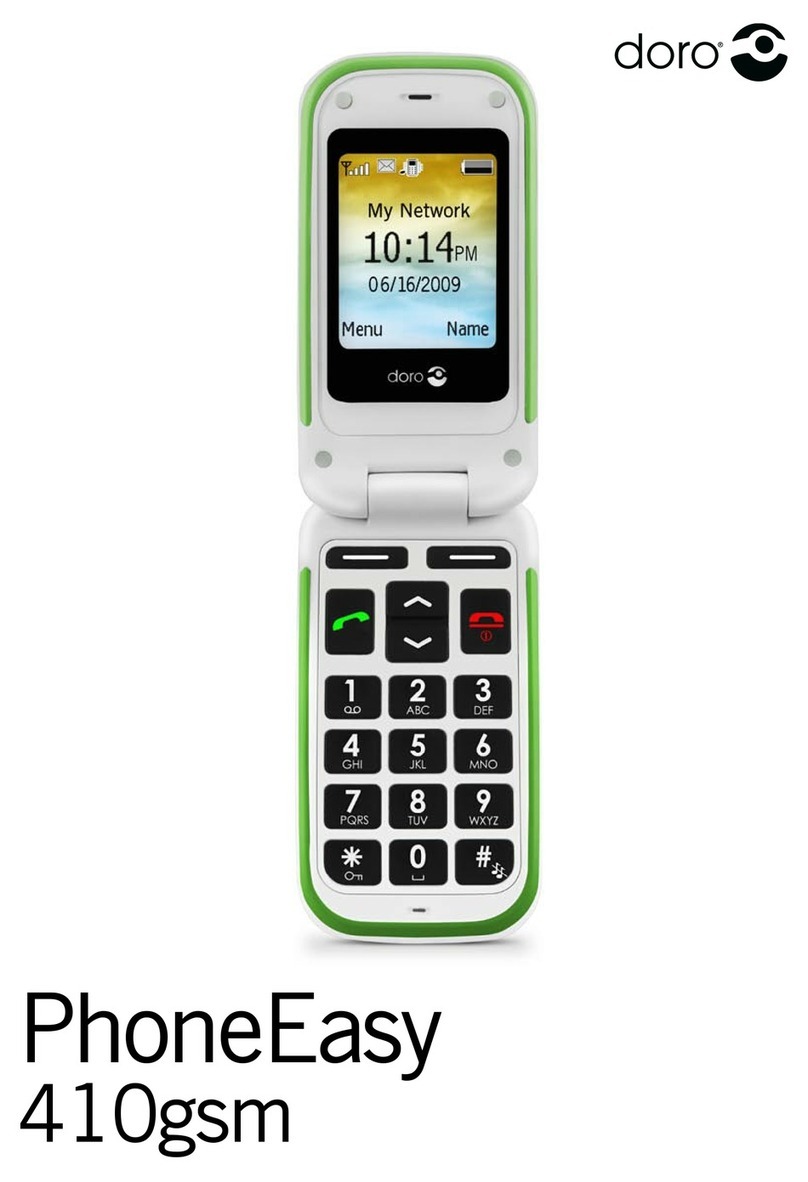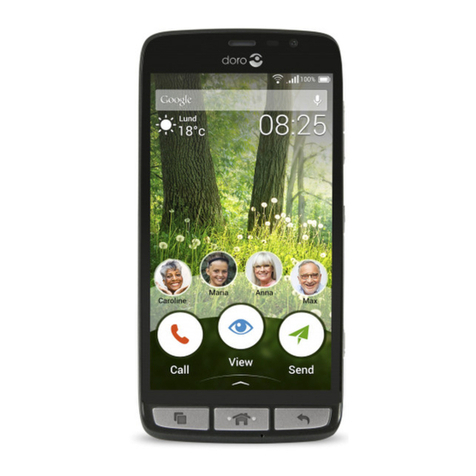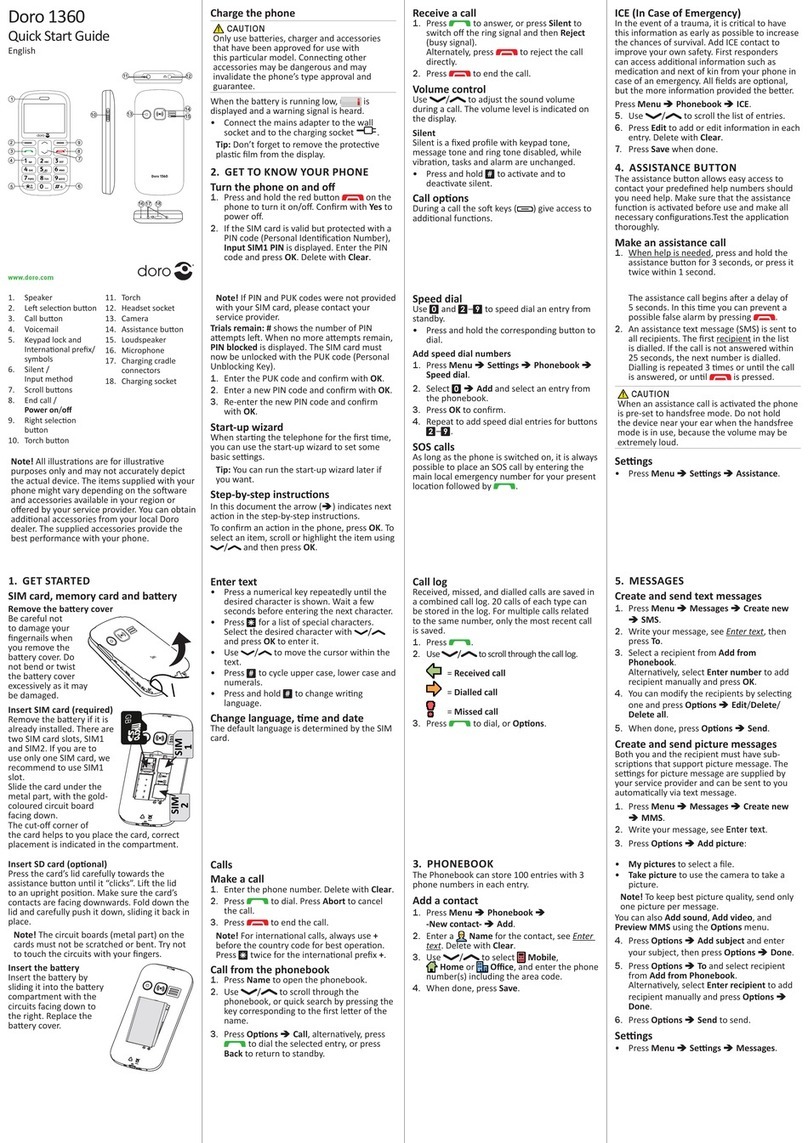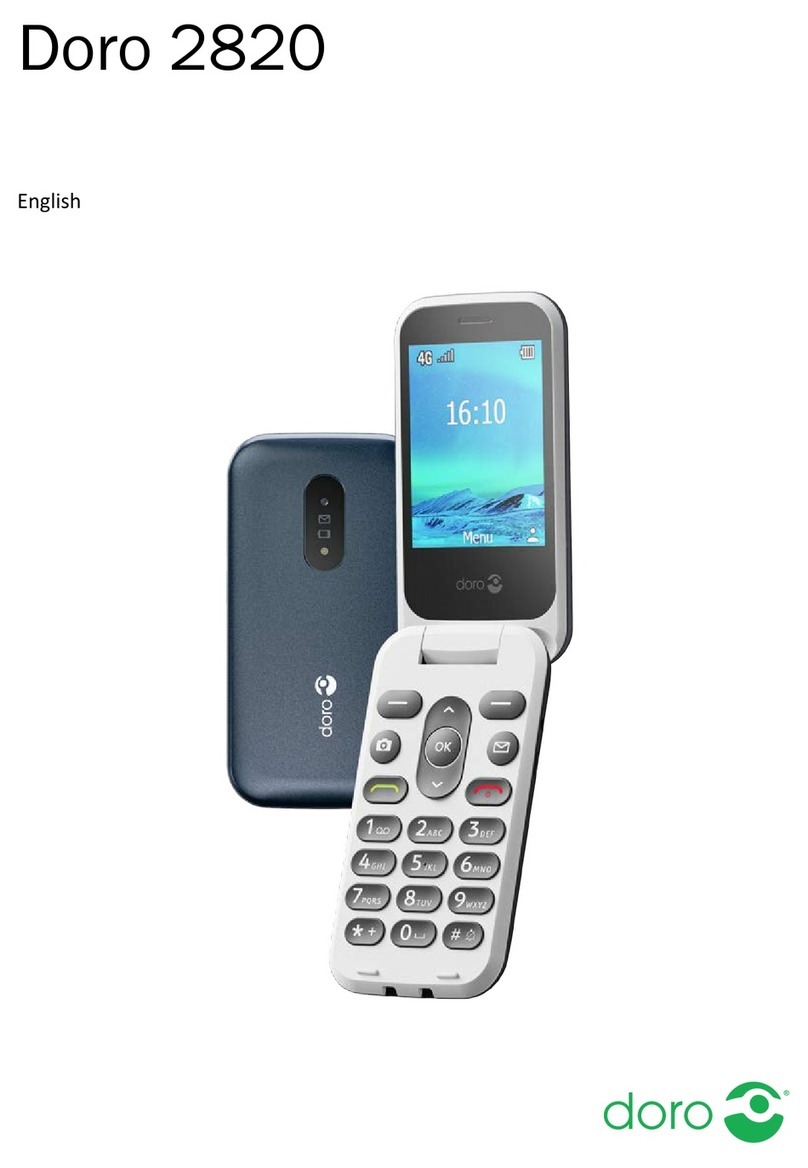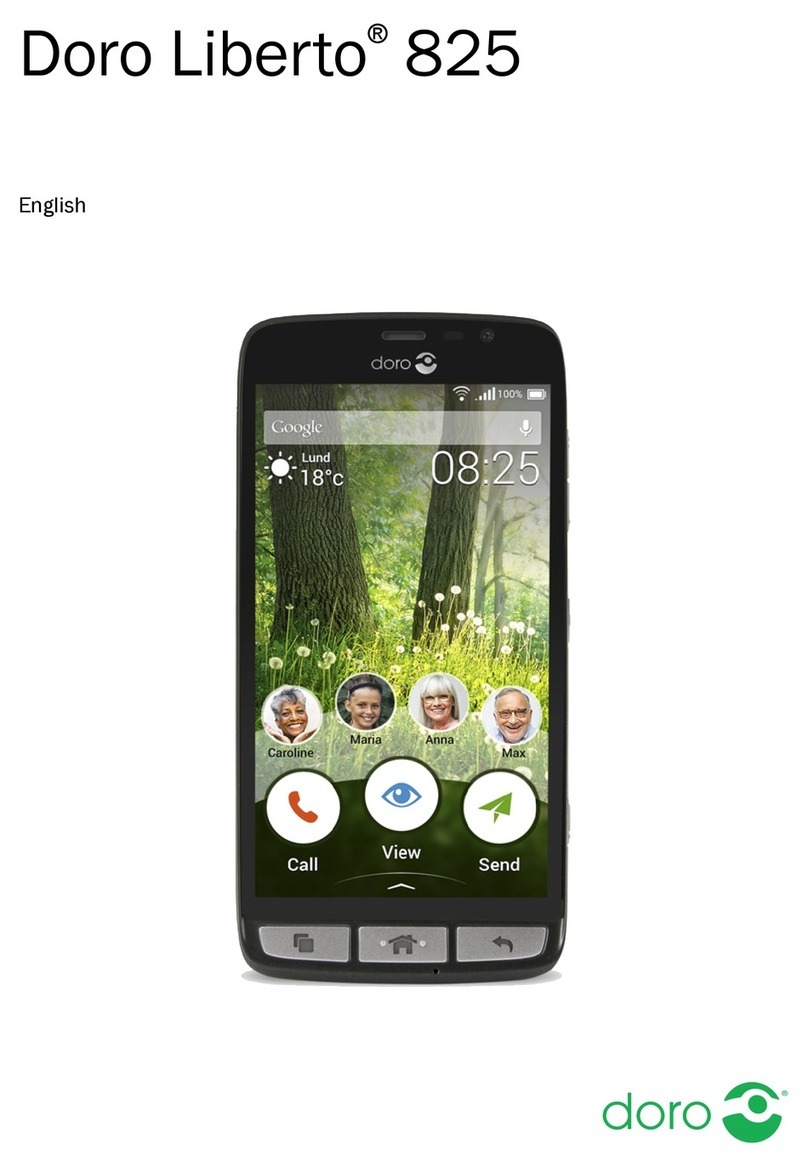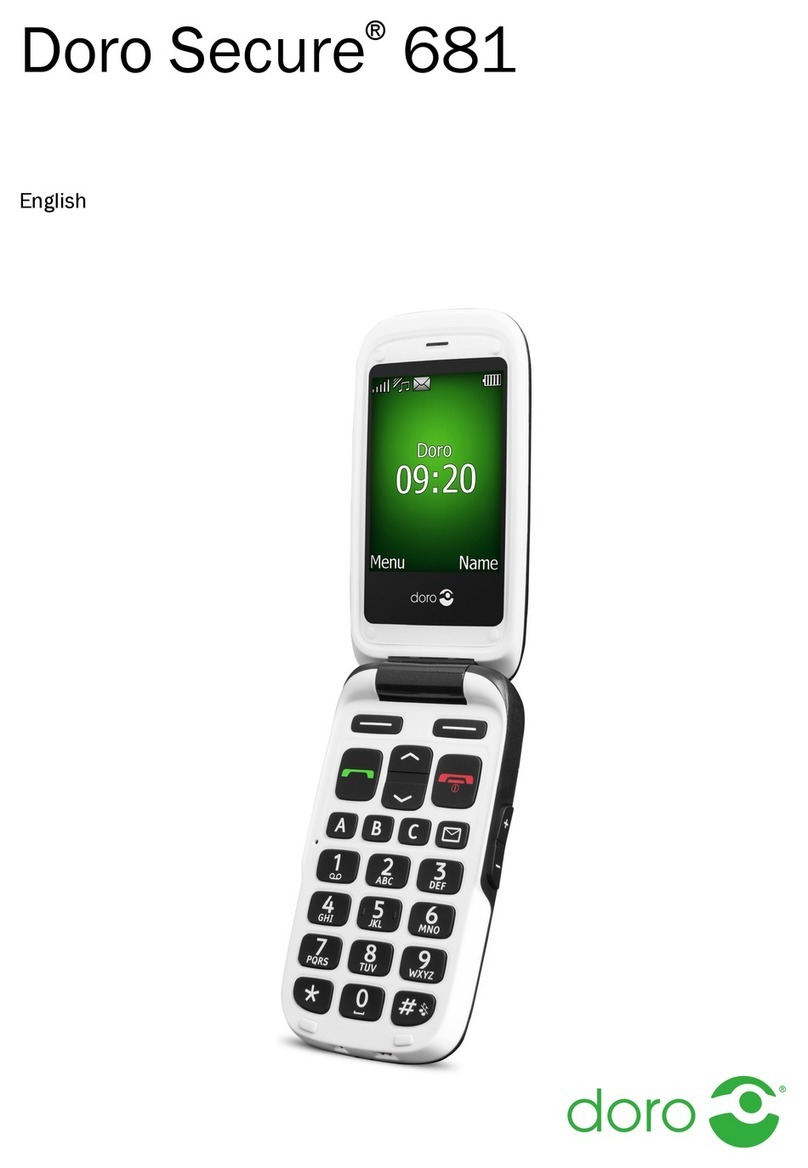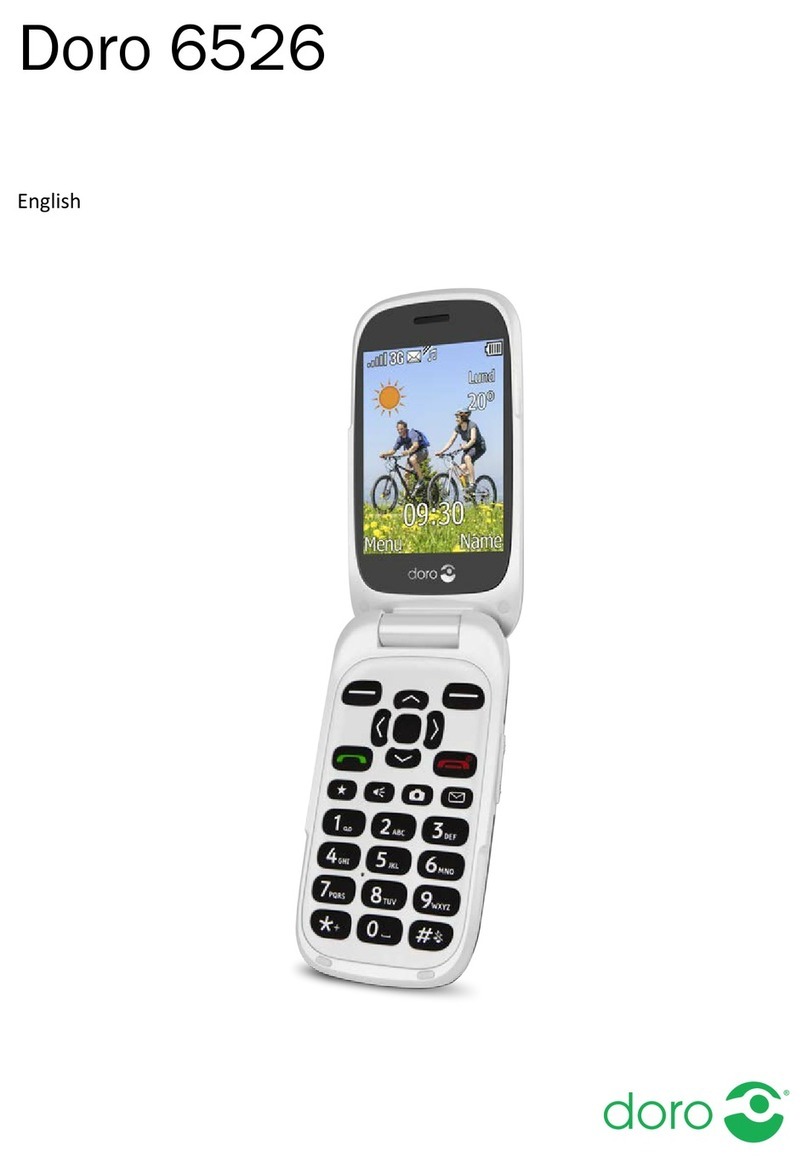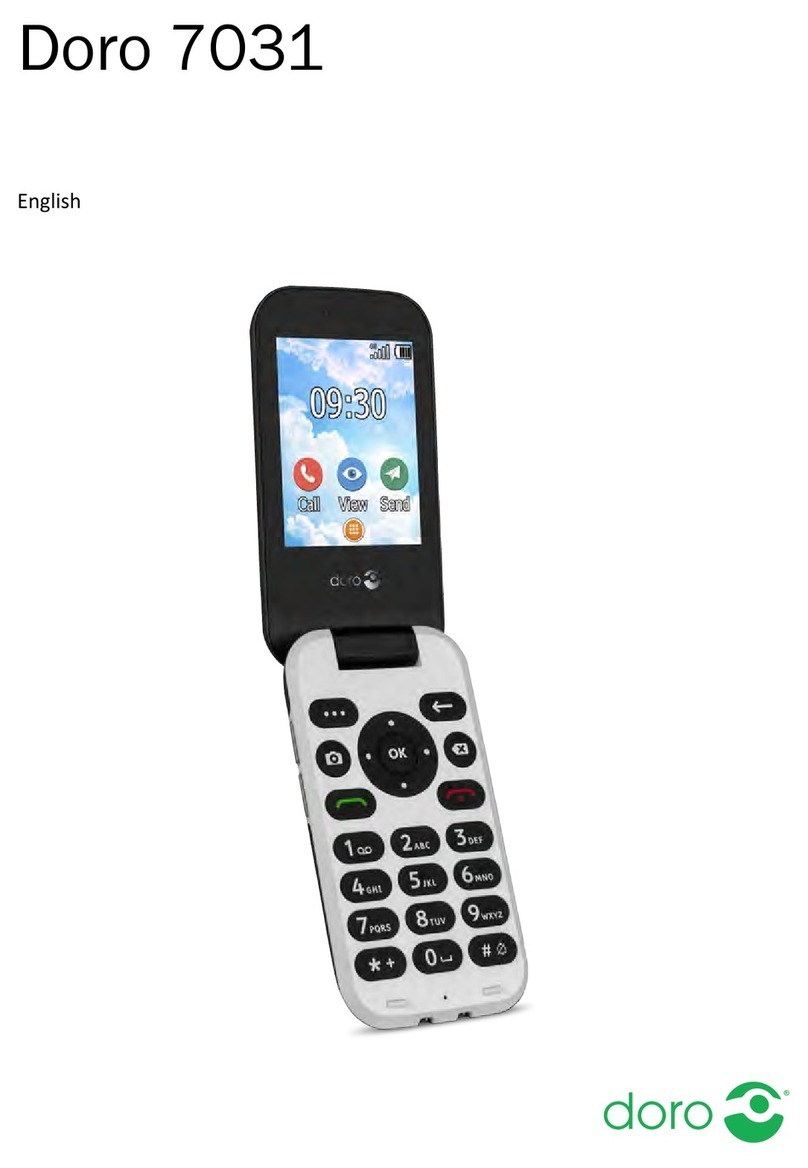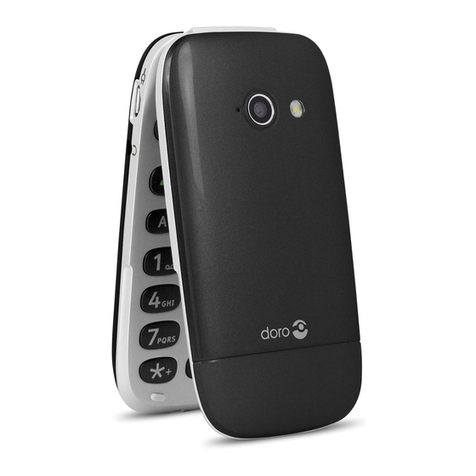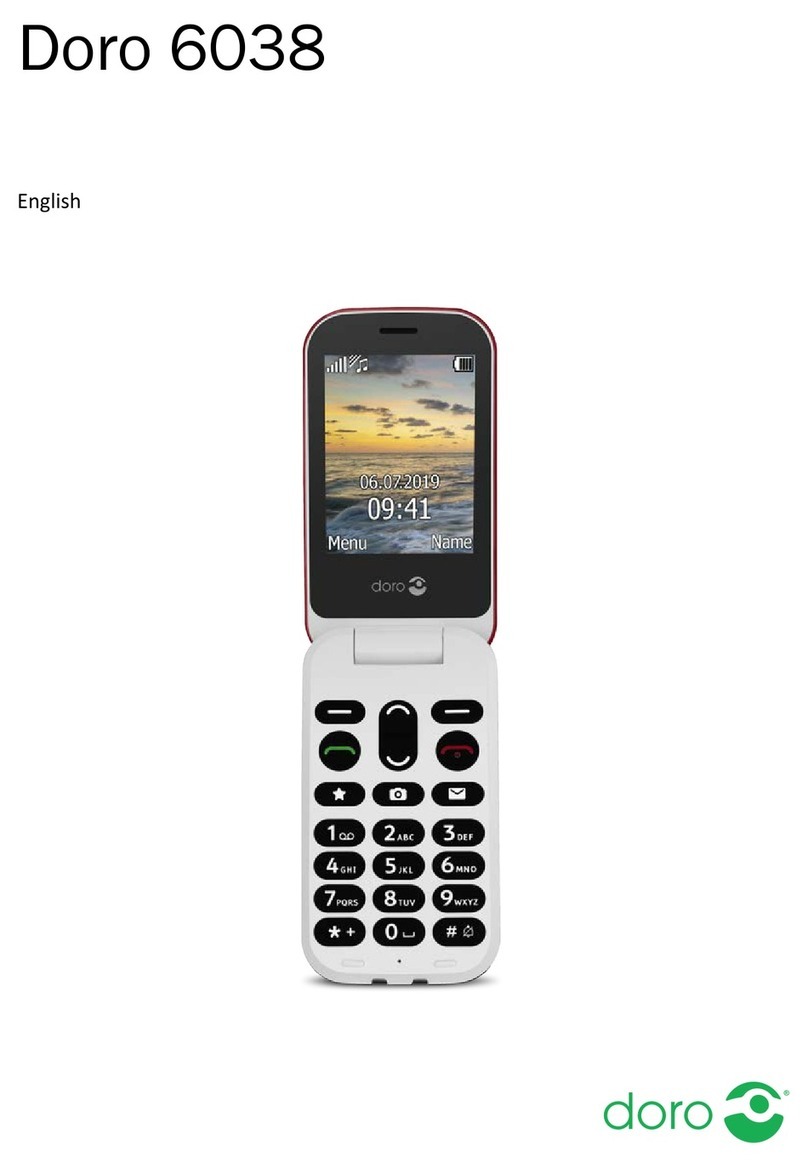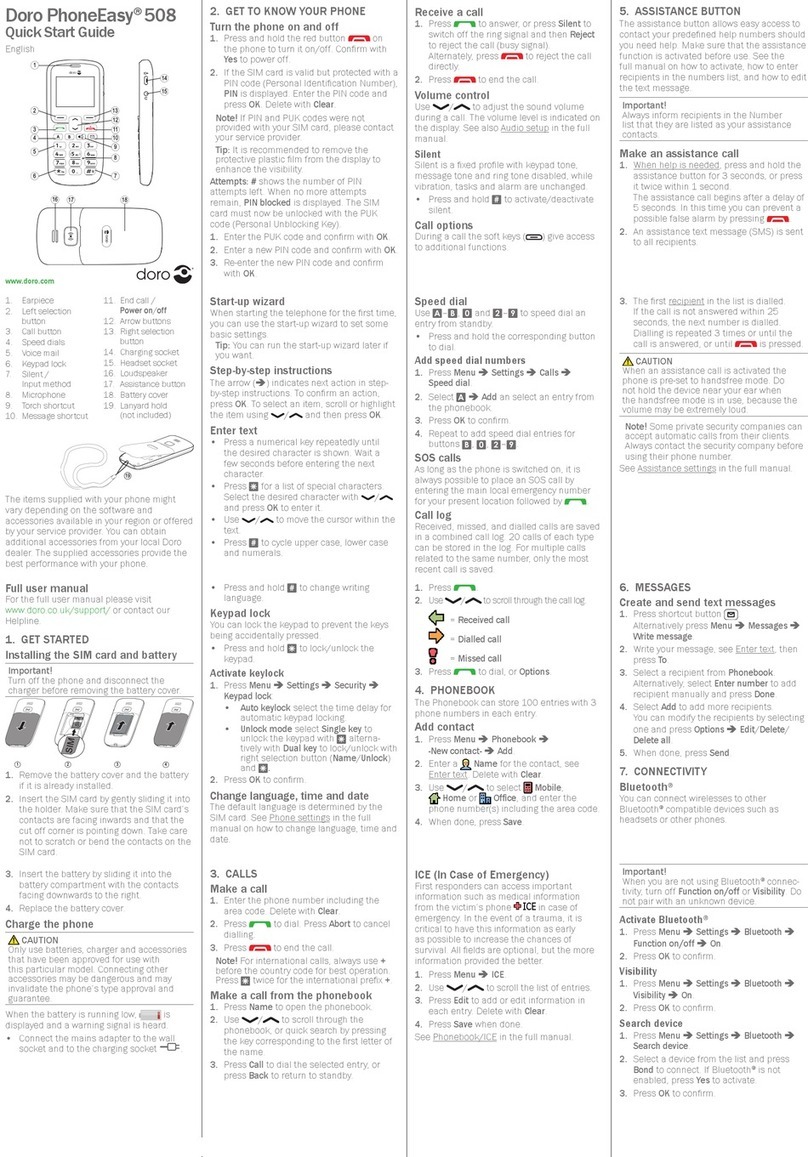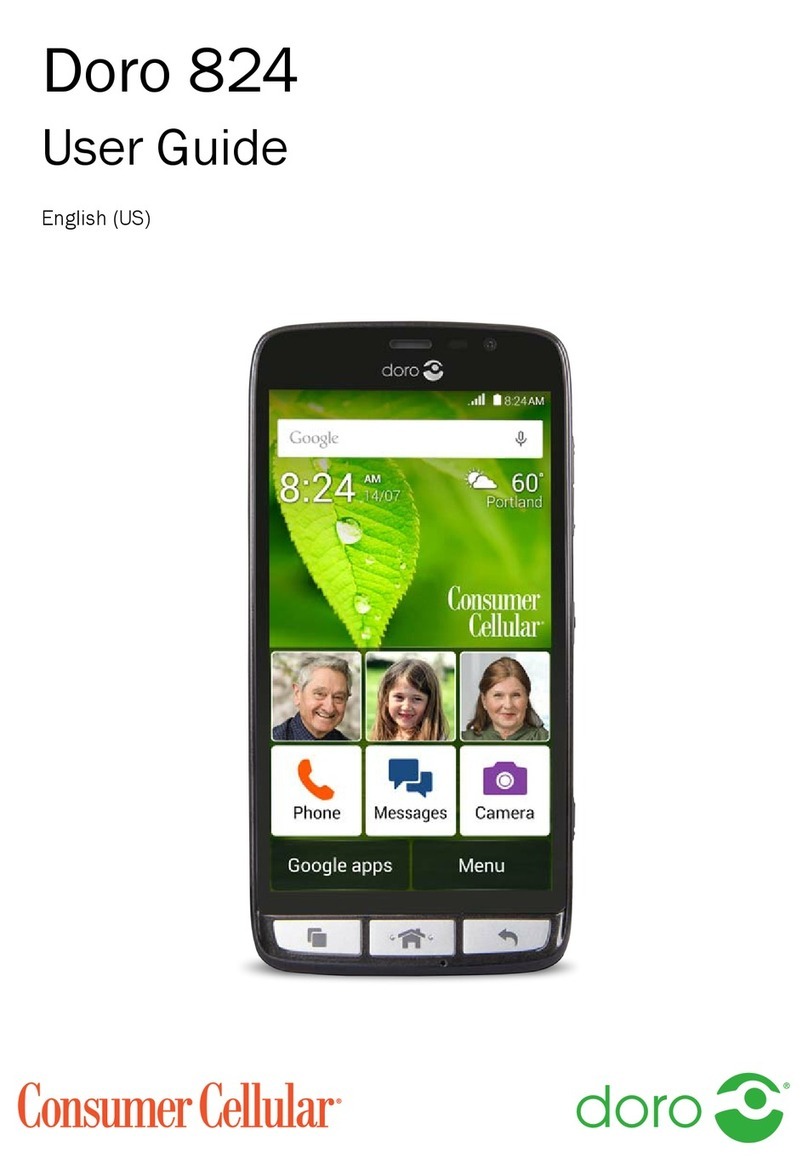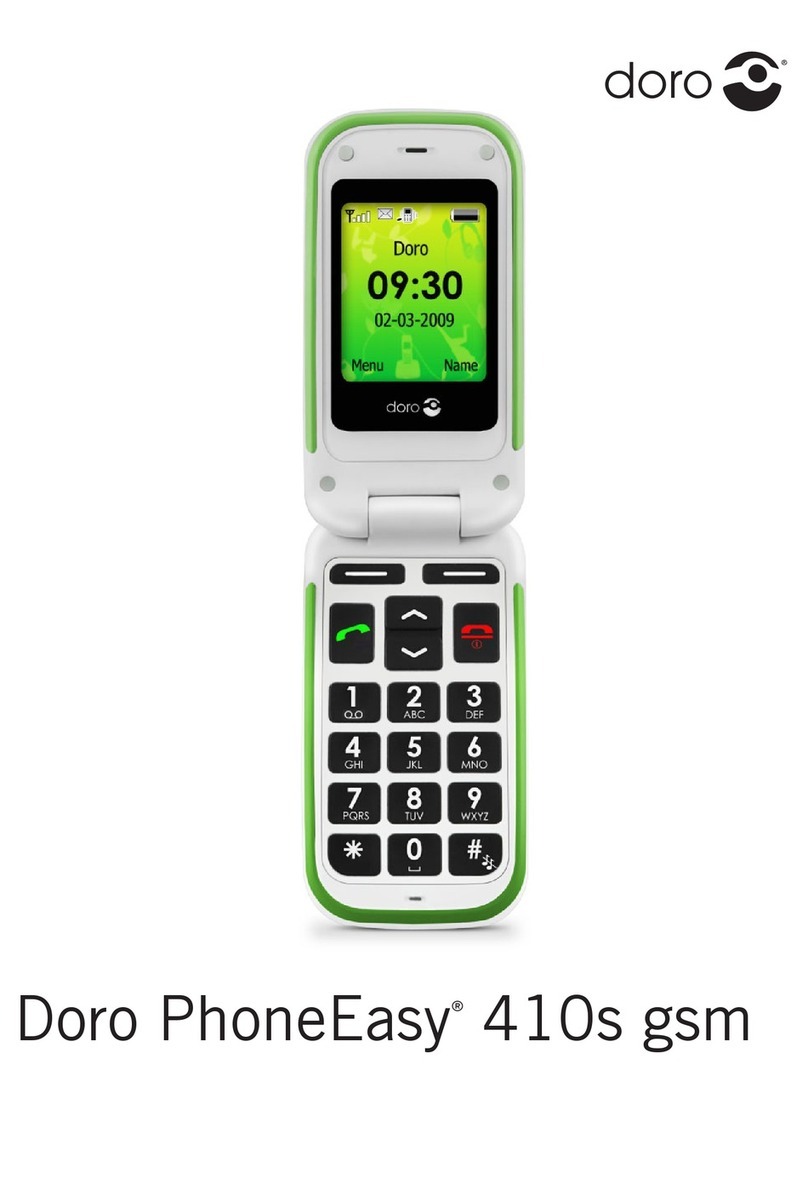
PhoneEasy 516 (1031)
FCC ID: WS5DORO516
QSG
English (AU/NZ)
Version 1.1
©2014 Doro AB. All rights reserved. 0700
8. CALL LOG
Received, missed, and dialled calls are saved
in a combined call log. 20 calls of each type
can be stored in the log. For multiple calls
related to the same number, only the most
recent call is saved.
Retrieving and dialling
1. Press .
2. Use /to scroll through the call log.
=
Received call
=
Dialled call
=
Missed call
3. Press to dial the number.
9. ASSISTANCE BUTTON
The assistance button allows easy access to
contact your predened help numbers should
you need help. The assistance function may
need to be activated before use. See the
full manual on how to activate, how to enter
recipients in the numbers list, and how to edit
the text message.
• Press
Menu
â
Settings
â
Assistance
.
Important!
Always inform recipients in the Number
list that they are listed as your assistance
contacts.
CAUTION
When an assistance call is activated the
phone is pre-set to handsfree mode. Do
not hold the device near your ear when
the handsfree mode is in use, because the
volume may be extremely loud.
Note! Some private security companies can
accept automatic calls from their clients.
Always contact the security company before
using their phone number.
See Settings/Assistance in the full manual.
10. MESSAGES
Create and send text messages
1. Press shortcut button .
Alternatively press
Menu
â
Messages
.
2. Select
Create new
â
SMS
.
3. Write your message, see Entering text,
then press
To
.
4. Select a recipient from
Phonebook
.
Alternatively, select
Enter number
to add
recipient manually and press
Done
.
5. Select
Add
to add more recipients.
You can modify the recipients by selecting
one and press
Options
â
Edit
/
Delete
/
Delete all
.
6. Press
Send
to send.
Create and send picture messages
1. Press shortcut button .
Alternatively press
Menu
â
Messages
.
2. Select
Create new
â
MMS
.
3. Write your message, see Entering text.
4. Press
Options
â
Add picture
:
•
My pictures
to select an existing picture.
•
Take picture
to use the camera to take a
picture.
You can also
Add sound
and
Add video
using the
Options
menu.
5. Select
Add subject
and enter your subject,
then press
Done
.
6. Select
To
and select a recipient from
Phonebook
.
Alternatively, select
Enter number
to add
recipient manually and press
Done
.
7. Select
Add
to add more recipients.
8. Press
Send
to send.
11. ICE (IN CASE OF EMERGENCY)
First responders can access important infor-
mation such as medical information from the
victim’s phone in case of emergency. In
the event of a trauma, it is critical to have this
information as early as possible to increase
the chances of survival. All elds are optional,
but the more information provided the better.
1. Press
Menu
â
ICE
.
2. Use / to scroll the list of entries.
3. Press
Edit
to add or edit information in
each entry. Delete with
Clear
.
4. Press
Save
when done.
See Phonebook/ICE in the full manual.
12. SETTINGS
The settings described in this chapter are
carried out in standby mode. Press to
return to standby mode.
Tone setup
1. Press
Menu
â
Settings
â
Sound
.
2. Select
Tone setup
â
Ringtone
.
3. Use / to select one of the available
melodies, the melody will be played.
4. Press
OK
to conrm or
Back
to discard chan-
ges.
Themes
You can select different themes to personali-
se the phones display text and background.
1. Press
Menu
â
Settings
â
Display
â
Themes
.
2. Use / to select a theme.
3. Press
OK
to conrm.
13. SAFETY INSTRUCTIONS
WARNING
The unit and the accessories can contain small parts.
Keep all of the equipment out of the reach of small
children.
The mains adapter is the disconnect device between
the product and mains power. The mains socket outlet
must be close to the equipment and easily accessible.
Network services and costs
Your device is approved for use on the WCDMA 850/2100MHz,
GSM 900/1800/1900MHz networks. To use the device, you
need a subscription with a service provider.
Using network services may result in trafc costs. Some
product features require support from the network, and you
may need to subscribe to them.
Operating environment
Follow the rules and laws that apply wherever you are, and
always turn off the unit whenever its use is prohibited or can
cause interference or hazards. Only use the unit in its normal
user position.
This unit complies with guidelines for radiation when it is used
either in a normal position against your ear, or when it is at
least 1.5 cm from your body. If the unit is carried close to
your body in a case, belt holder or other holder, these holders
should not contain any metal, and the product should be
placed at the distance from your body specied above. Make
sure that the distance instructions above are followed until the
transfer is complete.
Parts of the unit are magnetic. The unit can attract metal
objects. Do not keep credit cards or other magnetic media
near the unit. There is a risk that information stored on them
can be erased.
Medical units
The use of equipment that transmits radio signals, for example,
mobile phones, can interfere with insufciently protected medical
equipment. Consult a doctor or the manufacturer of the equipment
to determine if it has adequate protection against external radio
signals, or if you have any questions. If notices have been put up at
health care facilities instructing you to turn off the unit while you are
there, you should comply. Hospitals and other health care facilities
sometimes use equipment that can be sensitive to external radio
signals
Implanted medical devices
To avoid potential interference, manufacturers of implanted
medical devices recommend a minimum separation of 15 cm
between a wireless device and the medical device. Persons
who have such devices should:
• Always keep the wireless device more than 15 cm from the
medical device.
• Not carry the wireless device in a breast pocket.
• Hold the wireless device to the ear opposite the medical device.
If you have any reason to suspect that interference is taking
place, turn the phone off immediately. If you have any
questions about using your wireless device with an implanted
medical device, consult your health care provider.
Areas with explosion risk
Always turn off the unit when you are in an area where there
is a risk of explosion. Follow all signs and instructions. There is
a risk of explosion in places that include areas where you are
normally requested to turn off your car engine. In these areas,
sparks can cause explosion or re which can lead to personal
injury or even death.
Turn off the unit at lling stations, and any other place that has
fuel pumps and auto repair facilities.
Follow the restrictions that apply to the use of radio equipment
near places where fuel is stored and sold, chemical factories
and places where blasting is in progress. Areas with risk for
explosion are often – but not always – clearly marked. This
also applies to below decks on ships; the transport or storage
of chemicals; vehicles that use liquid fuel (such as propane or
butane); areas where the air contains chemicals or particles,
such as grain, dust or metal powder.
Li-ion battery
This product contains a Li-ion battery. There is a risk of re and
burns if the battery pack is handled improperly.
WARNING
Danger of explosion if battery is incorrectly replaced. To
reduce risk of re or burns, do not disassemble, crush,
puncture, short external contacts, expose to tempera-
ture above 60° C (140° F), or dispose of in re or water.
Recycle or dispose of used batteries according to the local
regulations or reference guide supplied with your product.
Protect your hearing
WARNING
Excessive exposure to loud sounds can
cause hearing damage.
Exposure to loud sounds while driving
may distract your attention and cause an
accident.
Listen to a headset at a moderate level,
and do not hold the device near your ear
when the loudspeaker is in use.
Emergency calls
Important!
Mobile phones use radio signals, the mobile phone
network, the terrestrial network and user-programmed
functions. This means that connection cannot be guar-
anteed in all circumstances. Therefore, never rely only
on a mobile phone for very important calls such as
medical emergencies.
Vehicles
Radio signals can affect electronic systems in motor vehicles
(for example, electronic fuel injection, ABS brakes, automatic
cruise control, air bag systems) that have been incorrectly
installed or are inadequately protected. Contact the manu-
facturer or its representative for more information about your
vehicle or any additional equipment.
Do not keep or transport ammable liquids, gases or explo-
sives together with the unit or its accessories.
For vehicles equipped with air bags: Remember that air bags
ll with air with considerable force. Do not place objects,
including xed or portable radio equipment in the area above
the airbag or the area where it might expand.
Serious injuries may be caused if the mobile phone equipment
is incorrectly installed and the airbag lls with air.
It is prohibited to use the unit in ight. Turn off the unit before
you board a plane. Using wireless telecom units inside a plane
can pose risks to air safety and interfere with telecommunica-
tions. It may also be illegal.
14. CARE AND MAINTENANCE
Your unit is a technically advanced product and should be
treated with the greatest care. Negligence may void the
warranty.
• Protect the unit from moisture. Rain/snowfall, moisture and all
types of liquid can contain substances that corrode the electronic
circuits. If the unit gets wet, you should remove the battery and
allow the unit to dry completely before you replace it.
• Do not use or keep the unit in dusty, dirty environments. The unit’s
moving parts and electronic components can be damaged.
• Do not keep the unit in warm places. High temperatures can
reduce the lifespan for electronic equipment, damage batteries
and distort or melt certain plastics.
• Do not keep the unit in cold places. When the unit warms up to
normal temperature, condensation can form on the inside which
can damage the electronic circuits.
• Do not try to open the unit in any other way than that which is
indicated here.
• Do not drop the unit. Do not knock or shake it either. If it is treated
roughly the circuits and precision mechanics can be broken.
• Do not use strong chemicals to clean the unit.
The advice above applies to the unit, battery, mains adapter
and other accessories. If the phone is not working as it should,
please contact the place of purchase for service. Don’t forget
the receipt or a copy of the invoice.
15. SPECIFICATIONS
Network: WCDMA 850/2100MHz,
GSM 900/1800/1900 MHz
Dimensions: 119 mm x 53 mm x 14 mm
Weight: 93 g (including battery)
Battery: 3.7V/800 mAh Li-ion battery
Operating ambient temperature: Min: 0°C (32°F) Max: 40°C (104°F)
Charging ambient temperature: Min: 0°C (32°F) Max: 40°C (104°F)
Storage temperature: Min: -20°C (-4°F) Max: 60°C (140°F)
Copyright and other notices
©2014 Doro AB. All rights reserved.
Bluetooth® is a registered trademark of Bluetooth SIG, inc.
eZiType™ is a trademark of Zi Corporation.
vCard is a trademark of the Internet Mail Consortium.
microSD is a trademark of SD Card Association.
The contents of this document are provided “as is”. Except as
required by applicable law, no warranties of any kind, either express
or implied, including, but not limited to, the implied warranties of
merchantability and tness for a particular purpose, are made in
relation to the accuracy, reliability or contents of this document.
Doro reserves the right to revise this document or withdraw it at any
time without prior notice.
Other product and company names mentioned herein may be the
trademarks of their respective owners.
Any rights not expressly granted herein are reserved. All other
trademarks are property of their respective owners.To the maximum
extent permitted by applicable law, under no circumstances shall
Doro or any of its licensors be responsible for any loss of data or
income or any special, incidental, consequential or indirect damages
howsoever caused.
Doro does not provide a warranty for or take any responsibility for the
functionality, content, or end-user support of third-party apps provided
with your device. By using an app, you acknowledge that the app is
provided as is. Doro does not make any representations, provide a
warranty, or take any responsibility for the functionality, content, or
end-user support of third-party apps provided with your device.
Content copyright
The unauthorised copying of copyrighted materials is contrary to
the provisions of the Copyright Laws of the United States and other
countries. This device is intended solely for copying non-copyrighted
materials, materials in which you own the copyright, or materials
which you are authorised or legally permitted to copy. If you are
uncertain about your right to copy any material, please contact your
legal advisor.
Specic Absorption Rate (SAR)
Bands WCDMA 2100 MHz, GSM 900/1800 MHz
This device meets applicable international safety requirements
for exposure to radio waves. The highest SAR value under the
ICNIRP guidelines for use of the device at the ear is 0.913 W/
kg measured over 10 g tissue.
The maximum limit according to ICNIRP is 2.0 W/kg measured
over 10 g tissue.
RF exposure information (SAR)
Bands WCDMA 850 MHz, GSM 1900 MHz
This model phone meets the government’s requirements
for exposure to radio waves. This phone is designed and
manufactured not to exceed the emission limits for exposure
to radio frequency (RF) energy set by the Federal Communica-
tions Commission of the U.S. Government and by the Canadian
regulatory authorities.
The exposure standard for wireless mobile phones employs a
unit of measurement known as the Specic Absorption Rate,
or SAR. The SAR limit set by the FCC and by the Canadian regu-
latory authorities is 1.6W/kg. *Tests for SAR are conducted
using standard operating positions accepted by the FCC and
Industry Canada with the phone transmitting at its highest
certied power level in all tested frequency bands. Although
the SAR is determined at the highest certied power level,
the actual SAR level of the phone while operating can be
well below the maximum value. This is because the phone
is designed to operate at multiple power levels so as to use
only the poser required to reach the network. In general, the
closer you are to a wireless base station antenna, the lower
the power output.
The highest SAR value for the model phone as reported to the
FCC when tested for use at the ear is 1.004 W/kg and when
worn on the body, as described in this user guide,
is 0.91 W/kg (Body-worn measurements differ among phone
models, depending upon available enhancements and FCC
requirements.)
While there may be differences between the SAR levels of
various phones and at various positions, they all meet the
government requirement. The FCC has granted an Equipment
Authorization for this model phone with all reported SAR
levels evaluated as in compliance with the FCC RF exposure
guidelines. SAR information on this model phone is on le with
the FCC and can be found under the Display Grant section of
http://www.fcc.gov/oet/ea/fccid after searching on FCC ID:
WS5DORO516
For body worn operation, this phone has been tested and
meets the FCC RF exposure guidelines for use with an
accessory that contains no metal and the positions the
handset a minimum of 5/8 inch (1.5 cm) from the body. Use of
other enhancements may not ensure compliance with FCC RF
exposure guidelines. If you do not use a body-worn accessory
and are not holding the phone at the ear, position the handset
a minimum of 5/8 inch (1.5 cm) from your body when the
phone is switched on.
*In the United States and Canada, the SAR limit for mobile
phones used by the public is 1.6 watts/kilogram (W/kg)
averaged over one gram of tissue. The standard incorporates
a substantial margin of safety to give additional protection for
the public and to account for any variations in measurements.
SAR values may vary depending on national reporting require-
ments and the network band.
FCC/Industry Canada notice
This device complies with part 15 of the FCC Rules and In-
dustry Canada license-exempt RSS standard(s). Operation is
subject to the following two conditions: (1) This device may not
cause harmful interference, and (2) this device must accept
any interference received, including interference that may
cause undesired operation.
This equipment has been tested and found to comply with the
limits for a Class B digital device, pursuant to part 15 of the
FCC Rules/Canadian ICES-003. These limits are designed to
provide reasonable protection against harmful interference
in a residential installation. This equipment generates, uses
and can radiate radio frequency energy and, if not installed
and used in accordance with the instructions, may cause
harmful interference to radio communications. However, there
is no guarantee that interference will not occur in a particular
installation. If this equipment does cause harmful interference
to radio or television reception, which can be determined by
turning the equipment off and on, the user is encouraged to
try to correct the interference by one or more of the following
measures:
• Reorient or relocate the receiving antenna.
• Increase the separation between the equipment and the receiver.
• Connect the equipment to an outlet on a circuit different from that
to which the receiver is connected.
• Consult the dealer or an experienced radio/TV technician for help.
The FCC or Industry Canada can require you to stop using your
unit if such interference cannot be eliminated.
Doro has not approved any changes or modications to this
device by the user. Any changes or modications could void he
user’s authority to operate the equipment.
Declaration of Conformity
Doro hereby declares that
Doro PhoneEasy
®
516
conforms
to the essential requirements and other relevant regulations
contained in the Directives
1999/5/EC (R&TTE) and 2002/95/EC (RoHS). A copy of the
Declaration of Conformity is available at www.doro.com/dofc.
WEEE
Disposal of Waste Equipment by Users in Private
Households in the European Union. This symbol on
the product or on its packaging indicates that this
product must not be disposed of with your other
household waste. Instead, it is your responsibility to
dispose of your waste equipment by handing it over
to a designated collection point for the recycling
of waste electrical and electronic equipment. The separate
collection and recycling of your waste equipment at the time
of disposal will help to conserve natural resources and ensure
that it is recycled in a manner that protects human health and
the environment. For more information about where you can
drop off your waste equipment for recycling, please contact
your local city ofce, your household waste disposal service or
the shop where you purchased the product.
Where batteries or accumulators are collected together with
waste electrical and electronic equipment on the basis of
Directive 2012/19/EC, batteries or accumulators shall be
removed from the collected waste electrical and electronic
equipment.
